Abstract
The ability of Lactobacillus bavaricus, a meat isolate, to inhibit the growth of three Listeria monocytogenes strains was examined in three beef systems: beef cubes, beef cubes in gravy, and beef cubes in gravy containing glucose. The beef was minimally heat treated, inoculated with L. bavaricus at 10(5) or 10(3) CFU/g and L. monocytogenes at 10(2) CFU/g, vacuum sealed, and stored at 4 or 10 degrees C. The meat samples were monitored for microbial growth, pH, and bacteriocin production. The pathogen was inhibited by L. bavaricus MN. At 4 degrees C, L. monocytogenes was inhibited or killed depending on the initial inoculum level of L. bavaricus. At 10 degrees C, at least a 10-fold reduction of the pathogen occurred, except in the beef without gravy. This system showed a transient inhibition of the pathogen during the first week of storage followed by growth to control levels by the end of the incubation period. Bacteriocin was detected in the samples, and inhibition could not be attributed to acidification. Low refrigeration temperatures significantly (P < or = 0.05) enhanced L. monocytogenes inhibition. Moreover, the addition of glucose-containing gravy and the higher inoculum level of L. bavaricus were significantly (P < or = 0.05) more effective in reducing L. monocytogenes populations in most of the systems studied.
Full text
PDF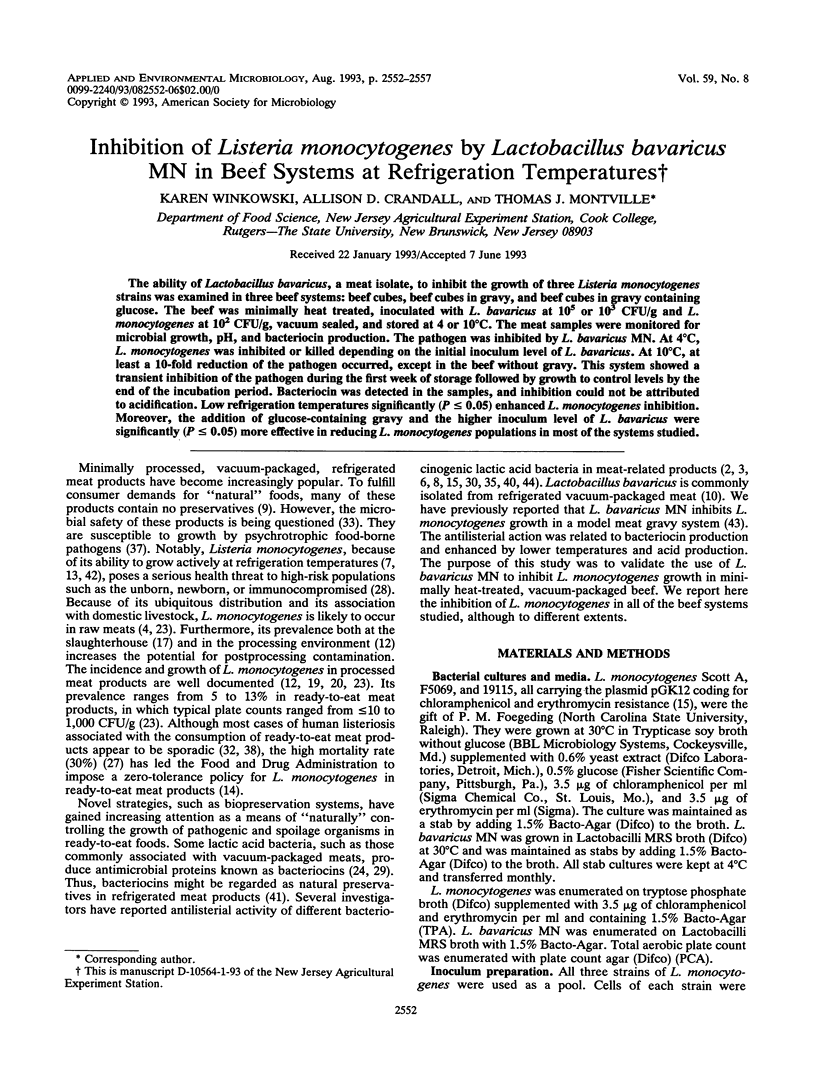
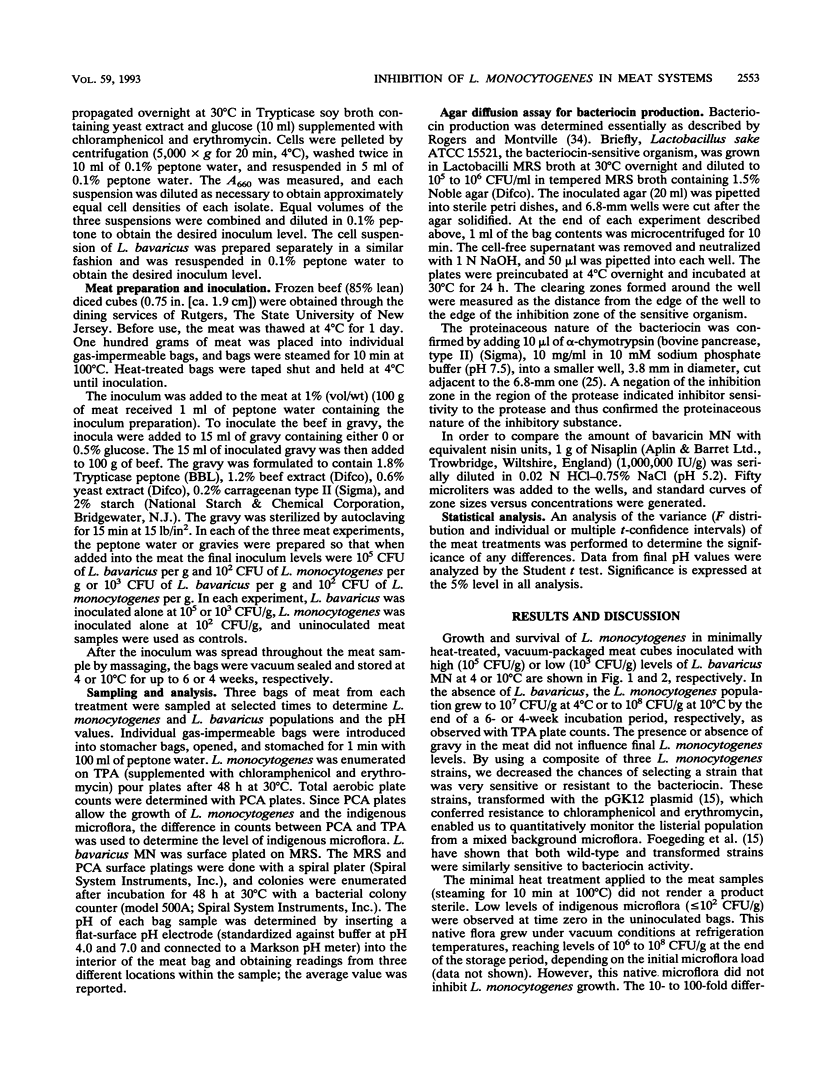
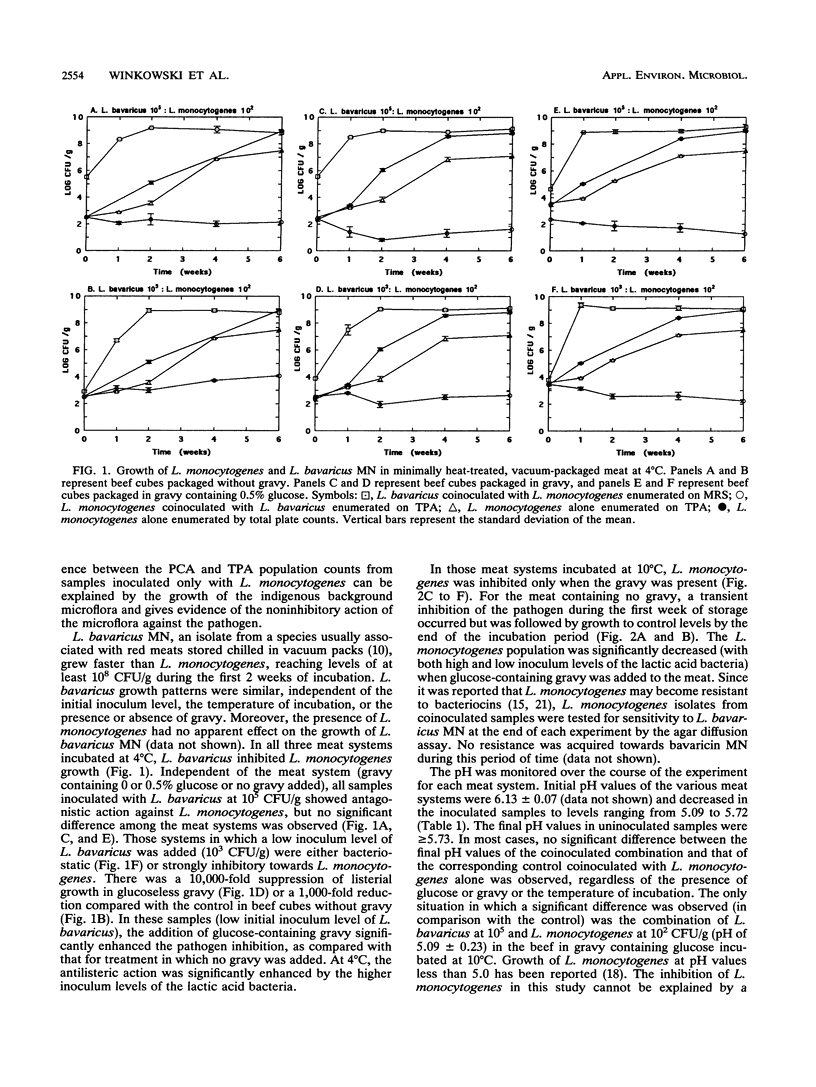
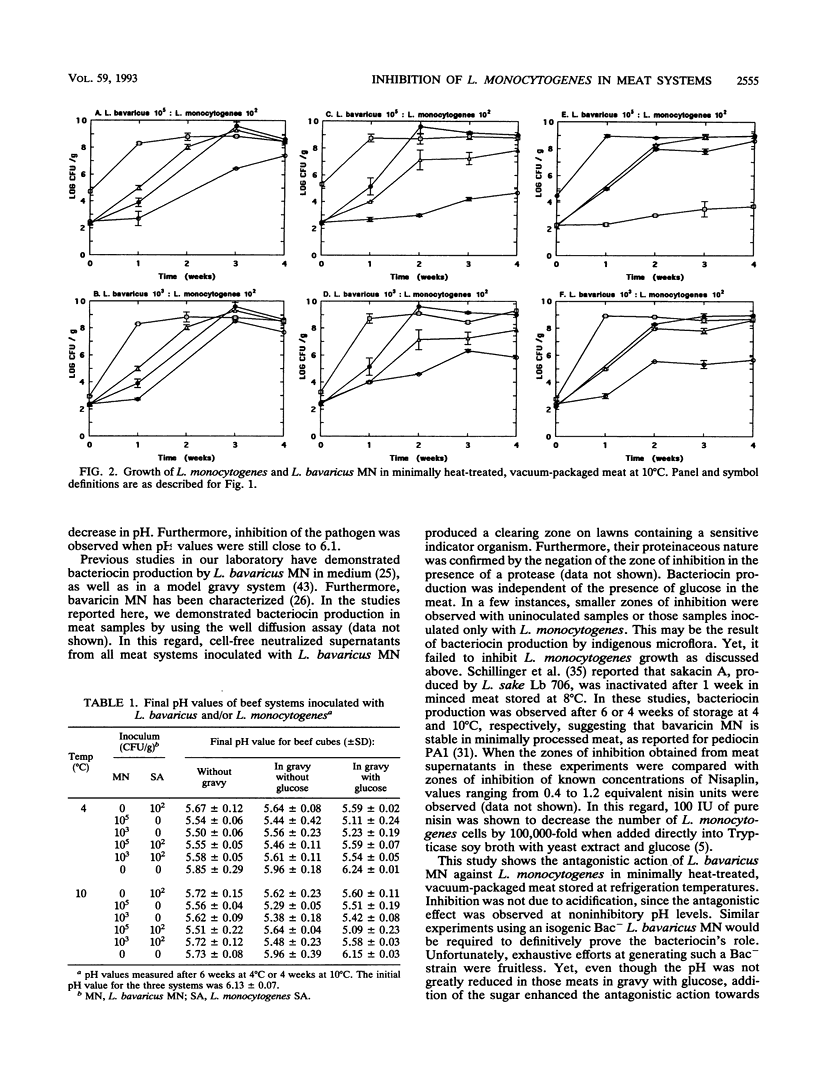
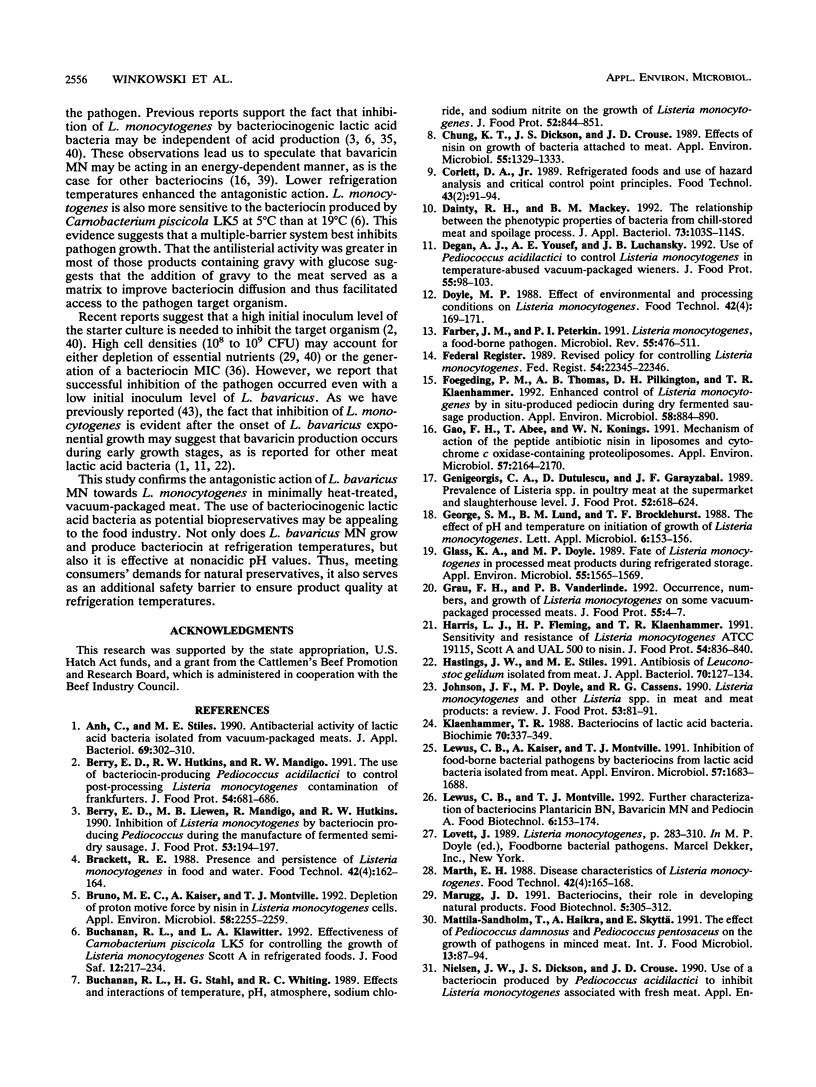
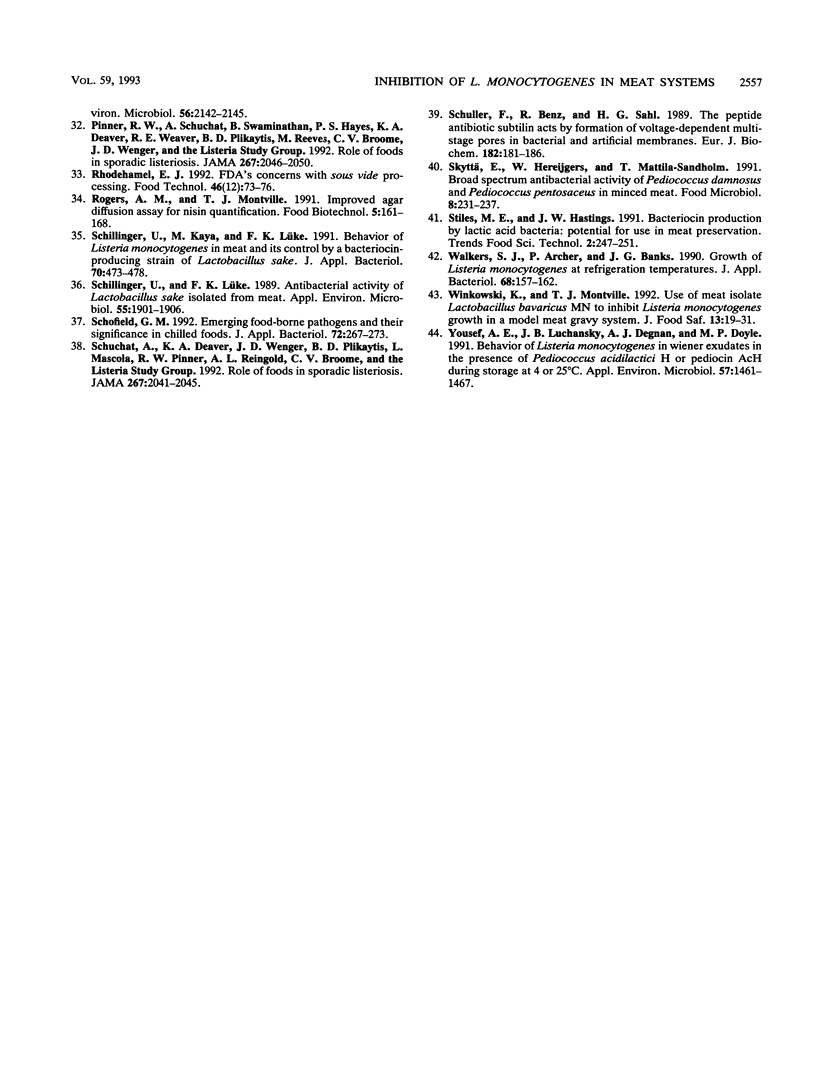
Selected References
These references are in PubMed. This may not be the complete list of references from this article.
- Ahn C., Stiles M. E. Antibacterial activity of lactic acid bacteria isolated from vacuum-packaged meats. J Appl Bacteriol. 1990 Sep;69(3):302–310. doi: 10.1111/j.1365-2672.1990.tb01520.x. [DOI] [PubMed] [Google Scholar]
- Bruno M. E., Kaiser A., Montville T. J. Depletion of proton motive force by nisin in Listeria monocytogenes cells. Appl Environ Microbiol. 1992 Jul;58(7):2255–2259. doi: 10.1128/aem.58.7.2255-2259.1992. [DOI] [PMC free article] [PubMed] [Google Scholar]
- Chung K. T., Dickson J. S., Crouse J. D. Effects of nisin on growth of bacteria attached to meat. Appl Environ Microbiol. 1989 Jun;55(6):1329–1333. doi: 10.1128/aem.55.6.1329-1333.1989. [DOI] [PMC free article] [PubMed] [Google Scholar]
- Dainty R. H., Mackey B. M. The relationship between the phenotypic properties of bacteria from chill-stored meat and spoilage processes. Soc Appl Bacteriol Symp Ser. 1992;21:103S–114S. doi: 10.1111/j.1365-2672.1992.tb03630.x. [DOI] [PubMed] [Google Scholar]
- Farber J. M., Peterkin P. I. Listeria monocytogenes, a food-borne pathogen. Microbiol Rev. 1991 Sep;55(3):476–511. doi: 10.1128/mr.55.3.476-511.1991. [DOI] [PMC free article] [PubMed] [Google Scholar]
- Foegeding P. M., Thomas A. B., Pilkington D. H., Klaenhammer T. R. Enhanced control of Listeria monocytogenes by in situ-produced pediocin during dry fermented sausage production. Appl Environ Microbiol. 1992 Mar;58(3):884–890. doi: 10.1128/aem.58.3.884-890.1992. [DOI] [PMC free article] [PubMed] [Google Scholar]
- Gao F. H., Abee T., Konings W. N. Mechanism of action of the peptide antibiotic nisin in liposomes and cytochrome c oxidase-containing proteoliposomes. Appl Environ Microbiol. 1991 Aug;57(8):2164–2170. doi: 10.1128/aem.57.8.2164-2170.1991. [DOI] [PMC free article] [PubMed] [Google Scholar]
- Glass K. A., Doyle M. P. Fate of Listeria monocytogenes in processed meat products during refrigerated storage. Appl Environ Microbiol. 1989 Jun;55(6):1565–1569. doi: 10.1128/aem.55.6.1565-1569.1989. [DOI] [PMC free article] [PubMed] [Google Scholar]
- Hastings J. W., Stiles M. E. Antibiosis of Leuconostoc gelidum isolated from meat. J Appl Bacteriol. 1991 Feb;70(2):127–134. doi: 10.1111/j.1365-2672.1991.tb04438.x. [DOI] [PubMed] [Google Scholar]
- Klaenhammer T. R. Bacteriocins of lactic acid bacteria. Biochimie. 1988 Mar;70(3):337–349. doi: 10.1016/0300-9084(88)90206-4. [DOI] [PubMed] [Google Scholar]
- Lewus C. B., Kaiser A., Montville T. J. Inhibition of food-borne bacterial pathogens by bacteriocins from lactic acid bacteria isolated from meat. Appl Environ Microbiol. 1991 Jun;57(6):1683–1688. doi: 10.1128/aem.57.6.1683-1688.1991. [DOI] [PMC free article] [PubMed] [Google Scholar]
- Mattila-Sandholm T., Haikara A., Skyttä E. The effect of Pediococcus damnosus and Pediococcus pentosaceus on the growth of pathogens in minced meat. Int J Food Microbiol. 1991 May;13(1):87–94. doi: 10.1016/0168-1605(91)90141-b. [DOI] [PubMed] [Google Scholar]
- Nielsen J. W., Dickson J. S., Crouse J. D. Use of a bacteriocin produced by Pediococcus acidilactici to inhibit Listeria monocytogenes associated with fresh meat. Appl Environ Microbiol. 1990 Jul;56(7):2142–2145. doi: 10.1128/aem.56.7.2142-2145.1990. [DOI] [PMC free article] [PubMed] [Google Scholar]
- Pinner R. W., Schuchat A., Swaminathan B., Hayes P. S., Deaver K. A., Weaver R. E., Plikaytis B. D., Reeves M., Broome C. V., Wenger J. D. Role of foods in sporadic listeriosis. II. Microbiologic and epidemiologic investigation. The Listeria Study Group. JAMA. 1992 Apr 15;267(15):2046–2050. [PubMed] [Google Scholar]
- Schillinger U., Kaya M., Lücke F. K. Behaviour of Listeria monocytogenes in meat and its control by a bacteriocin-producing strain of Lactobacillus sake. J Appl Bacteriol. 1991 Jun;70(6):473–478. doi: 10.1111/j.1365-2672.1991.tb02743.x. [DOI] [PubMed] [Google Scholar]
- Schillinger U., Lücke F. K. Antibacterial activity of Lactobacillus sake isolated from meat. Appl Environ Microbiol. 1989 Aug;55(8):1901–1906. doi: 10.1128/aem.55.8.1901-1906.1989. [DOI] [PMC free article] [PubMed] [Google Scholar]
- Schofield G. M. Emerging food-borne pathogens and their significance in chilled foods. J Appl Bacteriol. 1992 Apr;72(4):267–273. doi: 10.1111/j.1365-2672.1992.tb01834.x. [DOI] [PubMed] [Google Scholar]
- Schuchat A., Deaver K. A., Wenger J. D., Plikaytis B. D., Mascola L., Pinner R. W., Reingold A. L., Broome C. V. Role of foods in sporadic listeriosis. I. Case-control study of dietary risk factors. The Listeria Study Group. JAMA. 1992 Apr 15;267(15):2041–2045. [PubMed] [Google Scholar]
- Schüller F., Benz R., Sahl H. G. The peptide antibiotic subtilin acts by formation of voltage-dependent multi-state pores in bacterial and artificial membranes. Eur J Biochem. 1989 Jun 1;182(1):181–186. doi: 10.1111/j.1432-1033.1989.tb14815.x. [DOI] [PubMed] [Google Scholar]
- Walker S. J., Archer P., Banks J. G. Growth of Listeria monocytogenes at refrigeration temperatures. J Appl Bacteriol. 1990 Feb;68(2):157–162. doi: 10.1111/j.1365-2672.1990.tb02561.x. [DOI] [PubMed] [Google Scholar]
- Yousef A. E., Luchansky J. B., Degnan A. J., Doyle M. P. Behavior of Listeria monocytogenes in wiener exudates in the presence of Pediococcus acidilactici H or pediocin AcH during storage at 4 or 25 degrees C. Appl Environ Microbiol. 1991 May;57(5):1461–1467. doi: 10.1128/aem.57.5.1461-1467.1991. [DOI] [PMC free article] [PubMed] [Google Scholar]


